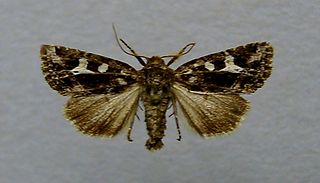
Apamea sordens, the rustic shoulder-knot or bordered apamea, is a moth of the family Noctuidae. The species was first described by Johann Siegfried Hufnagel in 1766. It is distributed throughout Europe, east across the Palearctic to Central Asia and to China and Japan. It also occurs in North America.

Phragmataecia castaneae, the reed leopard or giant borer, is a moth of the family Cossidae. It was described by Jacob Hübner in 1790. It is found in central and southern Europe, the Middle East, the Caucasus, Transcaucasia, Turkmenistan, Kazakhstan, north-western Iran, Iraq, Syria, Sri Lanka, Madagascar, India, Lebanon, Turkey, western China, south-western Siberia, Egypt, Tunisia and Morocco.

Psimada is a monotypic moth genus of the family Noctuidae. Its only species, Psimada quadripennis, is found in the Indian subregion, southern China, Taiwan, Myanmar, Thailand, Sri Lanka, the Andaman Islands, Sundaland, Sulawesi and Seram. Both the genus and species were first described by Francis Walker in 1858.

Spodolepis substriataria is a moth of the family Geometridae first described by George Duryea Hulst in 1896. It is found from Alaska to Nova Scotia, south in the east to New Jersey and in the west to California.

Celaena haworthii, or Haworth's minor, is a moth of the family Noctuidae. The species was first described by John Curtis in 1829. It is found from the British Isles and France through northern Europe including Scandinavia, east to the Urals and across the Palearctic to Siberia and up to the Pacific Ocean.

Pennisetia marginata, the raspberry crown borer or blackberry clearwing borer, is a moth of the family Sesiidae. The species was first described by Thaddeus William Harris in 1839. It is widespread in the United States, mainly in the east and along the Pacific Coast, ranging north into the southern parts of Canada. It is an introduced species in Hawaii.

Euzophera semifuneralis, the American plum borer, is a moth of the family Pyralidae. It is found throughout the United States, southern Canada and parts of Mexico.
Caloptilia glutinella is a moth of the family Gracillariidae. It is found in Canada and the United States. The species was first described by Charles Russell Ely in 1915.

Chilo plejadellus, the rice stalk borer moth, is a moth in the family Crambidae described by Johann Leopold Theodor Friedrich Zincken in 1821. It is found in North America, including Illinois, Ontario, Quebec, Pennsylvania, Georgia, Louisiana, Wisconsin, Texas and Arkansas.

Hellula rogatalis, the cabbage webworm, is a moth of the family Crambidae described by George Duryea Hulst in 1886. It is found from the southern United States north in the east to Maryland, New York and Ontario. It is also found in Mexico, where it has been recorded from Distrito Federal.

Iridopsis pergracilis, the cypress looper moth, is a moth of the family Geometridae. The species was first described by George Duryea Hulst in 1900. It is found in the US from Maryland to Florida.

Monoptilota is a genus of snout moths. It was described by George Duryea Hulst in 1900. It contains only one species, the lima-bean vine borer moth, which is found in the central and south-eastern parts of the United States.

Diatraea crambidoides, the southern cornstalk borer moth, is a species of moth of the family Crambidae described by Augustus Radcliffe Grote in 1880. It is found in North America, from Alabama and northern Florida to Ohio and Maryland. Its wingspan is 15–40 mm, and adults are straw colored to dull white. The forewings are slightly darker than the hindwings. There are two generations per year.
Papaipema birdi, the umbellifer borer, is a species of moth of the family Noctuidae. It is found from Quebec to Alberta and south in the east to New Jersey.

Euzophera is a genus of snout moths. It was described by Philipp Christoph Zeller in 1867.
Euzophera osseatella, the eggplant borer, is a species of snout moth in the genus Euzophera. It was described by Georg Friedrich Treitschke in 1832. It is found in Great Britain, France, Spain, Portugal, Italy, Sicily, Sardinia, Corsica, Croatia, Greece, Cyprus, Syria, Israel and North Africa.
Euzophera magnolialis, the magnolia root borer, is a species of snout moth in the genus Euzophera. It was described by Hahn William Capps in 1964. It is found in the southern United States.
Cactobrosis fernaldialis, the blue cactus borer, is a species of snout moth in the genus Cactobrosis. It was described by George Duryea Hulst in 1886, and is found from Texas to southern California, where it inhabits deserts.

Elophila gyralis, the waterlily borer moth, is a moth in the family Crambidae. It was described by George Duryea Hulst in 1886. It is found in eastern North America, where it has been recorded from Alabama, Florida, Georgia, Illinois, Indiana, Iowa, Louisiana, Maine, Maryland, Massachusetts, Michigan, Minnesota, Mississippi, New Brunswick, New Hampshire, New Jersey, New York, North Carolina, Nova Scotia, Ohio, Oklahoma, Ontario, Pennsylvania, Quebec, South Carolina, Tennessee, Texas and Wisconsin.

Macronoctua onusta, commonly known as the iris borer, is a species of cutworm or dart moth in the family Noctuidae. It is found in North America.















